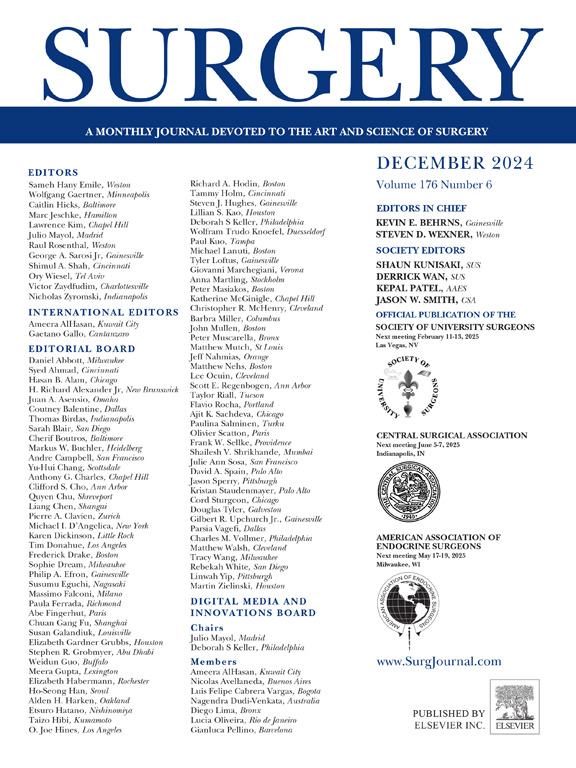生物制剂时代溃疡性结肠炎手术治疗的趋势-一项基于人群的研究,使用德国诊断相关组数据
IF 2.7
2区 医学
Q1 SURGERY
引用次数: 0
摘要
生物制剂的发展极大地促进了溃疡性结肠炎的治疗。然而,它们对手术病例数和并发症发生率的影响尚未明确确定。本研究的目的首先是描述在先进疗法时代手术的趋势和病例数,其次是分析那个时代手术技术和并发症的发展。方法对德国全国医院出院数据(诊断相关组)进行基于人群的分析,以评估2008年至2018年溃疡性结肠炎手术的时间趋势。所有诊断为溃疡性结肠炎的住院患者(国际疾病分类,第十版,代码K51.0-K51.9)均被纳入。来自德国联邦药物和医疗器械研究所的数据进行了检查,以确定德国生物制品市场的特征。结果本研究纳入522,705例诊断为溃疡性结肠炎的住院病例。在研究期间,生物制剂的上市许可数量有所增加(2021年累计总数为1227份)。部分结肠切除术的绝对数量下降(2008年为631例,2018年为585例;P = 0.003)和相对比例(1.5% ~ 1.1%;P & lt;.00001)。相反,结肠切除率增加(0.43% ~ 0.95%);P & lt;. 0.00001),直结肠切除术率稳定(2008年为0.93%,2018年为1.1%;P = 0.249)。在研究期间,微创手术率上升(14.5%至65.6%),转换率明显下降(15.4%至7.6%;P = .00395)。腹腔镜手术的并发症发生率明显低于开放手术(17%±4.6% vs 31.1%±2.0%;优势比为0.46,95%可信区间为0.41-0.52;P & lt;.00001)。结论在研究期间,尽管生物治疗的可用性越来越高,结肠切除术和直结肠切除术治疗溃疡性结肠炎的比例并未下降。本文章由计算机程序翻译,如有差异,请以英文原文为准。

Trends in surgical treatment for ulcerative colitis in the era of biologics – A population-based study using German diagnosis-related groups data
Background
The development of biologics has significantly advanced treatment of ulcerative colitis. However, their impact on the number of surgical cases and complication rates has not been clearly established. The aim of this study was first to describe trends and case numbers for surgery in the era of advanced therapies and second to analyze developments in surgical techniques and complications during that era.
Methods
A population-based analysis was performed on nationwide German hospital discharge data (diagnosis-related groups) to assess temporal trends in surgery for ulcerative colitis from 2008 to 2018. All inpatients with a diagnosis of ulcerative colitis (International Classification of Diseases, Tenth Revision, codes K51.0-K51.9) were included. Data from the German Federal Institute for Drugs and Medical Devices were examined to characterize the biologics market in Germany.
Results
The study included 522,705 in-hospital cases with a diagnosis of ulcerative colitis. An increase in marketing authorizations for biologics was noted during the study period (1,227 cumulative total in 2021). Partial colon resections declined in absolute numbers (631 in 2008 vs 585 in 2018; P = .003) and relative proportion (1.5% to 1.1%; P < .00001). Conversely, rates of colectomies increased (0.43% to 0.95%; P < .00001) and proctocolectomy rates were stable (0.93% in 2008 and 1.1% in 2018; P = .249). Within the study period the rate of minimally invasive surgery increased (14.5% to 65.6%), with a significant decrease in conversion rates (15.4% to 7.6%; P = .00395). Complication rates were significantly lower for laparoscopic compared with open surgery (17% ± 4.6% vs 31.1% ± 2.0%; odds ratio, 0.46, 95% confidence interval, 0.41–0.52; P < .00001).
Conclusion
Despite the increasing availability of biologic therapies, the rates of colectomy and proctocolectomy for ulcerative colitis did not decrease during the study period.
求助全文
通过发布文献求助,成功后即可免费获取论文全文。
去求助
来源期刊

Surgery
医学-外科
CiteScore
5.40
自引率
5.30%
发文量
687
审稿时长
64 days
期刊介绍:
For 66 years, Surgery has published practical, authoritative information about procedures, clinical advances, and major trends shaping general surgery. Each issue features original scientific contributions and clinical reports. Peer-reviewed articles cover topics in oncology, trauma, gastrointestinal, vascular, and transplantation surgery. The journal also publishes papers from the meetings of its sponsoring societies, the Society of University Surgeons, the Central Surgical Association, and the American Association of Endocrine Surgeons.
 求助内容:
求助内容: 应助结果提醒方式:
应助结果提醒方式:


